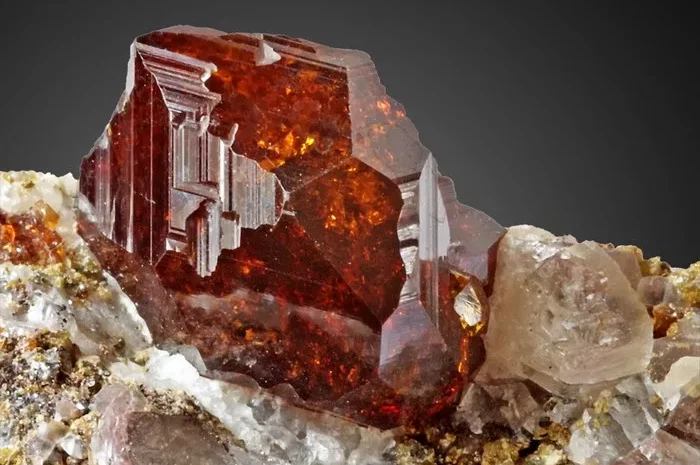Garnets are a group of silicate minerals that have been used since the Bronze Age as gemstones and abrasives. Known for their diverse colors and beauty, garnets are a favorite among gem enthusiasts. Among the various types of garnets, Purple Garnet and Rhodolite often spark curiosity and confusion due to their similar hues. This article explores the characteristics, origins, and differences between Purple Garnet and Rhodolite, providing clarity on whether they are the same.
Understanding Garnet
Garnets are a group of minerals that share a similar crystal structure but differ in chemical composition. The most common types of garnets include:
Almandine: Typically deep red to reddish-brown.
Pyrope: Known for its fiery red color.
Spessartine: Orange to reddish-orange hues.
Grossular: Varied colors including green, yellow, and pink.
Andradite: Includes varieties like demantoid (green) and melanite (black).
Uvarovite: Rich green, but rare in gem-quality.
Each of these types can occur in a variety of colors, making garnet a versatile gemstone.
What is Purple Garnet?
Purple Garnet is a term that can refer to several types of garnets that exhibit a purple hue. The purple color is typically a result of a combination of the almandine and pyrope varieties. This garnet can range from a soft lavender to a deep, vibrant purple.
Composition: Primarily a mix of almandine and pyrope, with varying amounts of other elements like manganese or chromium that can influence the color.
Color Range: From light lavender to deep purple, sometimes exhibiting a reddish or bluish tint depending on the specific composition.
Sources: Purple garnets are found in locations such as Mozambique, Tanzania, and Sri Lanka.
What is Rhodolite?
Rhodolite is a specific variety of garnet that is a blend of pyrope and almandine. It is known for its stunning color, which ranges from light to dark purplish-red.
Composition: Rhodolite is approximately 70% pyrope and 30% almandine, giving it a distinct purplish-red hue.
Color Range: From light to dark purplish-red, often with a pinkish or raspberry tone.
Sources: Major sources include the United States, Tanzania, Mozambique, and India.
Comparing Purple Garnet and Rhodolite
While Purple Garnet and Rhodolite share similarities, they are not the same gemstone. Here are key points of comparison:
Color and Hue
Purple Garnet: The term encompasses garnets with a broad range of purple hues, from light lavender to deep purple. The color can be more varied, sometimes with reddish or bluish undertones.
Rhodolite: Specifically has a purplish-red color, often described as raspberry or rose-colored. The hue is more consistent and defined within the purplish-red spectrum.
Chemical Composition
Purple Garnet: A mix of almandine and pyrope, but the proportions and additional trace elements can vary, leading to a wider range of colors.
Rhodolite: A specific blend of approximately 70% pyrope and 30% almandine, resulting in its consistent purplish-red color.
Rarity and Value
Purple Garnet: Can be found in several locations around the world, and its value depends on the intensity and uniformity of the purple color, as well as clarity and size.
Rhodolite: Considered one of the more valuable garnets due to its specific and desirable color. High-quality Rhodolite gemstones are highly sought after in the jewelry market.
Geological Formation
The formation process of garnets involves high-temperature and high-pressure conditions typically found in metamorphic rocks. Garnets can also form in igneous rocks and, in some cases, in sedimentary rocks that have undergone metamorphism.
Purple Garnet: Found in both metamorphic and igneous rocks. The specific geological conditions and presence of trace elements contribute to its purple hue.
Rhodolite: Primarily formed in metamorphic rocks. The unique blend of pyrope and almandine in Rhodolite results from specific metamorphic conditions that allow for the formation of this distinct garnet variety.
Uses in Jewelry
Both Purple Garnet and Rhodolite are popular choices for jewelry due to their vibrant colors and durability.
Purple Garnet: Often used in rings, earrings, and pendants. Its varying shades of purple can create unique and eye-catching pieces. Purple Garnet is also relatively hard (7-7.5 on the Mohs scale), making it suitable for daily wear.
Rhodolite: Highly prized in fine jewelry, especially for its rich, raspberry-like color. It is commonly used in high-end rings, necklaces, and brooches. Rhodolite’s consistent color and brilliance make it a favorite among jewelers and collectors.
See Also: Hessonite VS Rhodolite Garnet
Identifying and Differentiating
To differentiate between Purple Garnet and Rhodolite, gemologists use several techniques:
Color Examination: Observing the specific hue can provide clues. Rhodolite’s consistent purplish-red color is distinct compared to the broader range of purple hues in Purple Garnet.
Refractive Index: Rhodolite typically has a refractive index between 1.740 and 1.760, while Purple Garnet’s refractive index can vary depending on its exact composition.
Spectroscopy: Analyzing the absorption spectrum can help identify the specific garnet type based on its unique spectral lines.
Chemical Analysis: Advanced techniques like X-ray fluorescence (XRF) can determine the precise chemical composition, helping to distinguish between different garnet varieties.
Conclusion
In conclusion, while Purple Garnet and Rhodolite share similarities in their composition and appearance, they are not the same. Purple Garnet is a broader term that encompasses garnets with a range of purple hues, while Rhodolite is a specific variety of garnet known for its consistent purplish-red color. Understanding these differences is essential for gem enthusiasts, jewelers, and collectors to appreciate the unique qualities of each gemstone.
By recognizing the distinct characteristics of Purple Garnet and Rhodolite, one can make informed decisions when selecting gemstones for jewelry or collection purposes. Both gems offer stunning beauty and durability, making them valuable additions to any gem collection.


